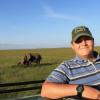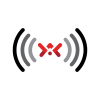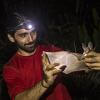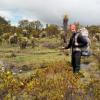Acoustic sensors enable efficient and non-invasive monitoring of a wide range of species, including many that are difficult to monitor in other ways. Although they were initially limited in application scope largely due to cost and hardware constraints, the development of low-cost, open-source models like the Audiomoth in recent years has increased access immensely and opened up new avenues of research. For example, some teams are using them to identify illicit human activities through the detection of associated sounds, like gunshots, vehicles, or chainsaws (e.g. OpenEars).
With this relatively novel dimension of wildlife monitoring rapidly advancing in both marine and terrestrial systems, it is crucial that we identify and share information about the utility and constraints of these sensors to inform efforts. A recent study identified advancements in hardware and machine learning applications, as well as early development of acoustic biodiversity indicators, as factors facilitating progress in the field. In terms of limitations, the authors highlight insufficient reference sound libraries, a lack of open-source audio processing tools, and a need for standardization of survey and analysis protocols. They also stress the importance of collaboration in moving forward, which is precisely what this group will aim to facilitate.
If you're new to acoustic monitoring and want to get up to speed on the basics, check out these beginner's resources and conversations from across the WILDLABS platform:
Three Resources for Beginners:
- Listening to Nature: The Emerging Field of Bioacoustics, Adam Welz
- Ecoacoustics and Biodiversity Monitoring, RSEC Journal
- Monitoring Ecosystems through Sound: The Present and Future of Passive Acoustics, Ella Browning and Rory Gibb
Three Forum Threads for Beginners:
- AudioMoth user guide | Tessa Rhinehart
- Audiomoth and Natterjack Monitoring (UK) | Stuart Newson
- Help with analysing bat recordings from Audiomoth | Carlos Abrahams
Three Tutorials for Beginners:
- "How do I perform automated recordings of bird assemblages?" | Carlos Abrahams, Tech Tutors
- "How do I scale up acoustic surveys with Audiomoths and automated processing?" | Tessa Rhinehart, Tech Tutors
- Acoustic Monitoring | David Watson, Ruby Lee, Andy Hill, and Dimitri Ponirakis, Virtual Meetups
Want to know more about acoustic monitoring and learn from experts in the WILDLABS community? Jump into the discussion in our Acoustic Monitoring group!
Header image: Carly Batist
- 0 Resources
- 0 Discussions
- 7 Groups
World Wide Fund for Nature/ World Wildlife Fund (WWF)

- 0 Resources
- 12 Discussions
- 15 Groups
- @tom_august
- | he/him
Computational ecologist with interests in computer vision, citizen science, open science, drones, acoustics, data viz, software engineering, public engagement



- 5 Resources
- 49 Discussions
- 5 Groups
- @amykukulya
- | she/her
Amy Kukulya is an ocean tech innovator and conservationist from the US. She has captured thrilling footage of megafauna using novel biologger and oceanrobotCams—SharkCam, TurtleCam featured across the globe on mainstream media outlets.
- 0 Resources
- 0 Discussions
- 7 Groups
- @TheDataEnthusiastic
- | He/Him
Hi, I'm pursuing Master's in Data Science. And I want work help protect nature and wildlife.
- 0 Resources
- 0 Discussions
- 14 Groups
- 0 Resources
- 2 Discussions
- 2 Groups
Recently accepted into the Rangeland, Wildlife and Fisheries graduate program at Texas A&M.
- 0 Resources
- 0 Discussions
- 1 Groups
- @maddy
- | Dr
Iam a Doctorate in molecular bology by profession & associated with a tech startup, focued on IoT/sensor based automation solutions. But I spend half of my time to document and conserve local & wildlife arond us and trying to explore our technology in conservation.Love to join
- 0 Resources
- 0 Discussions
- 2 Groups
- @claudlacroix
- | she/her
PhD fellow using deep learning to investigate marine fish acoustic signals and social behaviour.
- 0 Resources
- 0 Discussions
- 4 Groups
GreenLab

- 0 Resources
- 19 Discussions
- 8 Groups
- 0 Resources
- 0 Discussions
- 2 Groups
Over 35 years of experience in biodiversity conservation worldwide, largely focused on forests, rewilding and conservation technology. I run my own business assisting nonprofits and agencies in the conservation community


- 0 Resources
- 25 Discussions
- 11 Groups
Do you have photos and videos of your conservation tech work? We want to include them in a conservation technology showcase video
17 May 2024
Article
Read in detail about how to use The Inventory, our new living directory of conservation technology tools, organisations, and R&D projects.
1 May 2024
Article
The Inventory is your one-stop shop for conservation technology tools, organisations, and R&D projects. Start contributing to it now!
1 May 2024
Technology to End the Sixth Mass Extinction. Salary: $132 - $160k; Location: Seattle WA; 7+ years of experience in hardware product development and manufacturing; View post for full job description
1 May 2024
TBC is looking for an applicant to lead on the design, analysis and reporting of data from a wide range of innovative bat population monitoring surveys with a particular focus on passive acoustic monitoring, undertake...
24 April 2024
Full-time 3 year postdoctoral fellowship in Escondido, CA
22 April 2024
In a recent publication we tested Underwater Passive Acoustic Monitoring (UPAM) as a feasible non-invasive technique to study the calling behavior of therathened aquatic Andean frogs under natural conditions in the...
6 April 2024
What can soundscapes tell us about ecosystem functioning and health? We are looking to hire a postdoctoral researcher in ecoacoustics for Nature Recovery at Oxford
2 April 2024
Hussey Labs seeks a senior post-doctoral researcher/senior research associate for movement ecology of Greenland halibut in the context of fisheries management across Baffin Bay-Davis Strait, Eastern Canadian Arctic.
13 March 2024
Catch up on the conservation tech discussions and events that happened during World Wildlife Day 2024!
7 March 2024
Do you know anyone interested in this position? Let them know by sharing widely.
27 February 2024
The Ecological Acoustics and Behavior Lab at the University of New Hampshire seeks a PhD student to join our lab to investigate how forest habitat affects moose occupancy and soundscape in northern New Hampshire
13 February 2024
June 2024
July 2024
event
September 2024
event
November 2023
event
43 Products
Recently updated products
| Description | Activity | Replies | Groups | Updated |
|---|---|---|---|---|
| I love seeing how much this little device has taken off! |
|
Acoustics | 5 years 9 months ago | |
| Hi Stephanie, thanks for the update above. We will be doing two things this week to support the community. To meet the demand from Round 3 we require an essential component (... |
|
Acoustics | 6 years 1 month ago | |
| Hi all - WWF's upcoming Fuller Seminar will focus on biodiversity monitoring using acoustics. Instructions for remote participation are... |
|
Acoustics | 6 years 1 month ago | |
| Hi everyone, we have received an update from GroupGets on the shipping of the second group purchase. 'Quick update everyone. The boards are scheduled to ship to us... |
|
Acoustics | 6 years 3 months ago | |
| Thanks for that Steph - and for the link in included. A good set of papers there, and the review by Shonfield & Bayne on 'current use and future... |
|
Acoustics | 6 years 4 months ago | |
| Good news indeed, Al! I think a new thread is definitely a good idea - this one is getting rather unwieldy. @nilaksha, you might check out @Jan+Kees 's serval... |
+41
|
Acoustics | 6 years 5 months ago | |
| Great. Let's continue our discussion that through Skype ;-) My skype name is jkschakel and you can email me at [email protected]. I'm available on... |
|
Acoustics | 6 years 6 months ago | |
| Paul, Hi - is this still needed, as I'm sure we could provide something relating to birds, bats and cetaceans? Thanks, Carlos |
|
Acoustics | 6 years 7 months ago | |
| Steffen, Thanks for that tip-off, I'd not seen that paper before. One of the speakers at my bird bioacoustics meeting in July covered soundscape ecology, with some... |
|
Acoustics | 6 years 7 months ago | |
| In an effort to learn more about my group's members, I would like to pose a challenge to all of you. I would like to challenge each of... |
|
Acoustics | 6 years 8 months ago | |
| Wow, this would be amazing to continue on with the years of data I have from tigers! I understand their social lives are very different but it would be interesting to see what... |
|
Acoustics | 6 years 8 months ago | |
| Hi everyone, I happened upon this community on Twitter and I thought it would be the perfect place to post about the Wildlife... |
|
Acoustics | 6 years 11 months ago |
Data mgmt for Passive Acoustic Monitoring best practices?
14 September 2022 8:35pm
19 September 2022 1:58am
Hello Alex,
My information might not be that helpful to you, still, our organisation have an Enterprise license of AWS cloud and we store all our media files (video, pictures, audio etc.) there. We are also using a media management solution, Piction, thru which we upload the files into the S3 bucket and in the process it also captures the file metadata (some of the metadata values needs to be entered manually). This is useful to search the files if someone wants to view or process the file later. We are soon deciding on the file storage configuration so that old files will move to cheap storage like AWS Glacier, which will take a maximum of a week time to retrieve it.
Jitendra
28 October 2022 4:19pm
Hi Alex,
I'd go much further along the lines that David @dtsavage sets out. Before jumping to implementations, better think through why you want to keep all that data, and for who? From your question, it appears you have at least three purposes:
1- for yourself to do your research
2- for others to re-use.
3- for yourself to have a back-up
For 1) you should do what works best for you.
For 3) use your organization's back-up system or whatever comes close to that
For 2 and 3) As you are indicating yourself : deposit your data at your nation's repository or zenodo.org if your nation doe not have one. It may be some documentation work ( which is what you should do anyways, right? ), but then you can stop worrying about holding on to it. Someone else is doing that for you and they do a much better job - because it is their job. Moreover, you increase the chance that other will actually become aware of all that data that you are sitting on by putting it into a repository. Who is otherwise going to find out and how that you have those disks on your desk? Lastly, depositing your data can also serve as a back-up. If you don't want to share it before you've published about it, there is likely the option of depositing under time-embargo or of depositing while requiring your consent for any re-use.
You ask how many people actually do this? You can find the answers at the repository, but I suggest that what matters most is whether you want to for your own reasons, and whether your funders, or organization's funders require it.
Audiomoth online conference
24 October 2022 4:50pm
New conservation tech articles from Mongabay
20 October 2022 7:45pm
Software to aid acoustic sound files visualization/labelling + Software to syncronize video/acoustic sonograms
23 September 2022 1:01pm
8 October 2022 12:44am
I would also recommend Arbimon. It is well set up to handle Audiomoth recordings. Being cloud based, you will need a good internet connection for sound file upload. I'm just starting to investigate its use for Song Scope recordings. Setting up the call recognisers will be a slow process, but they can be made available to all users once done.
8 October 2022 7:33am
You could try using a video editor like DaVinci for looking at your video and audio together. I don't think DaVinci displays sonograms by default (just waveform) but I think it will open your selected audio in an external editor which would allow you to see the sonograms and make measurements with something like Audacity or Kaleidoscope.
20 October 2022 11:01am
The open-source program Audacity can show the spectrograms and histograms and has quite a lot of other useful features, e.g. playing ultrasound calls slower, so it can be heard by people.
Conservation Technology Intern (Vietnam)
 Meredith S. Palmer
Meredith S. Palmer
19 October 2022 9:22am
Acoustic Monitoring Biologist (Avian)
19 October 2022 12:11am
New paper: Benthic animal-borne sensors & citizen science combine to validate ocean modelling
10 October 2022 4:15pm
"We develop the use of benthic species as animal oceanographers by combining archival (depth, temperature) data from animal-borne tags, passive acoustic telemetry & citizen-science mark-recapture records for the flapper skate in Scotland."
The Smart Biosphere: How Technology can provide regenerative resources at scale
10 October 2022 12:06pm
Open Position at Cornell - Software/Firmware Developer
6 October 2022 5:10pm
Multi-day workshop: Machine Learning Advances for Marine Acoustics & Imagery Data
4 October 2022 5:20pm
Audio Across Domains Workshop 2022
3 October 2022 7:54pm
3 October 2022 11:40pm
11 October 2022 2:05pm
New paper - Rookognise: Acoustic detection & identification of individual rooks in field recordings using multi-task neural networks
3 October 2022 2:35pm
Authors developed system to acoustically identify individual animals (under varying conditions) using combo of multi-scale information integration, multi-channel audio & multi-task learning. Tested on captive group of rooks.
New paper: Battery-free wireless imaging of underwater environments
29 September 2022 3:22pm
'The low-power camera uses power from harvested acoustic energy and communicates colour images wirelessly via acoustic backscatter.' - https://twitter.com/NaturePortfolio/status/1574863768714100738?s=20&t=d…
New paper: Seasonal swarming behavior of Myotis bats revealed by integrated monitoring, involving passive acoustic monitoring with automated analysis, trapping & video monitoring
27 September 2022 3:22pm
Authors 'examined effectiveness of acoustic monitoring compared to capture-based & video monitoring of seasonal swarming behavior among Myotis bats in UK. The 3 approaches have advantages & disadvantages for different tasks, but can be highly complementary methods.'
Conservation Tech Directory - new update!
29 August 2022 2:38pm
23 September 2022 5:26pm
Congrats on the milestone Carly and Gracie!
26 September 2022 10:07pm
Thanks so much!!
Audio Data Across Domains (AudioXD) Workshop
6 June 2022 3:52pm
1 September 2022 11:46am
Great minds Alice!! I'd actually sent your workshop to justin separately this morning because of the alignment with audioxd.
As for joining things up globally, I think you're right. Looking at all that's happening in the bioacoustics community right now, seeing all these sort of events, what's happening with the bioacoustics stack exchange, and hearing the conversations that are happening - and it feels like such an opportune time to find a way to support all of these efforts link up and join forces. We have some plans on this front that will mean we'll be able to provide coordination support to help, and I'm interested to hear what people think is needed.
Steph
1 September 2022 3:21pm
Thanks Alice, and great to hear from you and Steph about the work that you all are leading. It would be great to follow up on the idea of doing more international collaboration in the ecoacoustics/bioacoustics space. If you're interested, feel free to drop me a line to catch up sometime about ideas.
Also, something of a side note, but we'll also have a Wildlabs blog post up summarizing the AudioXD meeting soon, hopefully.
26 September 2022 9:22pm
I love the idea of increasing international collaboration and inclusion within acoustic monitoring! I think there particularly needs to be more collab'ing between the terrestrial & aquatic/marine acoustic monitoring folks!
It would be great for more virtual/hybrid events to foster such international inclusion, so anything to facilitate that sort of online platform would be awesome!
There is also the new Bioacoustics Stack Exchange for Q&A. And the upcoming IBAC conference in Japan next October (2023).
Ecological Forecasting Initiative's data analysis webinar series
26 September 2022 6:50pm
New paper: A novel method for identifying coded tags recorded on aquatic acoustic monitoring systems
26 September 2022 2:11pm
Authors demonstrated "a low cost, simple method to support acoustic tag surveys by identifying tags both from direct acoustic recordings & by reconstructing code packets from processed C-POD data. Method was applied to decode tag detections from bass & Twaite shad."
Mangrove soundscape
27 August 2022 4:57pm
29 August 2022 2:47pm
You might check out the devices listed in the Conservation Tech Directory - you can search for 'acoustic recorder' or 'ARU' or something like that.
The most common off-the-shelf models (other than Frontier Labs' BARLTs mentioned above😊) are Open Acoustic Devices Audiomoths & Hydromoths (which may be particularly useful for you since they come in completely watertight cases that can be stuck underwater for deployments), Wildlife Acoustics' SongMeter series, and Cornell Lab of Ornithology's Swift units.
30 August 2022 10:10pm
Camilo--
Are you interested only in airborne sounds or do you want to deploy hydrophones? That decision would inform a lot of other decisions about your purchase of equipment, as would having a clearer picture of your budget.
23 September 2022 5:39pm
Hi there Camilo,
What an interesting project! If you are looking for a lower cost, but effective tools for acoustic monitoring you might want to look into two options:
SoundTraps - are very commonly used and perform quite well:
SonarPoints - these are also a great instrument option:
Senior Conservation Technology Expert Position (Consultancy) with the Global Wildlife Program
22 September 2022 5:35pm
New paper: Passive acoustic monitoring as a tool to investigate the spatial distribution of invasive alien species
21 September 2022 2:07am
Authors developed reproducible passive acoustic monitoring pipeline to rapidly provide baseline information on invasive alien species (IAS); found that IAS occurrence related to high levels of human disturbance.
New paper: Evaluation of a coastal acoustic buoy for cetacean detections, bearing accuracy and exclusion zone monitoring
20 September 2022 3:00pm
Authors "developed a three-hydrophone passive acoustic monitoring system that provides bearing information along with marine mammal detections to allow for informed management decisions in real-time."
New paper: Soundscapes show disruption across the diel cycle in human modified tropical landscapes
20 September 2022 2:40pm
Authors founds dawn & dusk choruses were lost/supressed in plantations, acoustic activity at dawn/dusk reduced in disturbed ecosystems compared to healthy forests.
WILDLABS Journal Club
15 September 2022 11:42am
15 September 2022 12:17pm
Ah Journal club - this was a lot of fun but a little chaotic. We've been wondering if we should bring it back with a slightly different format. ie we all agree on a paper to read before rather than bringing a mix of things to present. What does everyone think? Is anyone else keen? Is there a format you'd suggest we use?
15 September 2022 3:49pm
I have been waiting for journal club to come back!! 10000% down.
I agree with @StephODonnell, would love it to come back!!! And now that variety hour is happening, that's more of the "mix of things" that she mentioned anyways so I think that new format would be great.
Online Course – Introduction to Aquatic Acoustic Telemetry
14 September 2022 6:13pm
CFP - transnational biodiversity monitoring (from European Biodiversity Partnership)
14 September 2022 1:42pm
Join the BirdNET team!
9 September 2022 2:43pm














































15 September 2022 4:20pm
Hi Alex--
The first thing I'd suggest you think through is how much data you have vs how much data you are currently working on. Because if you have data from previous years that you want to ensure you're storing securely and reliably but don't need immediate access to in order to run analysis on, that opens up some options. You can compress data using lossless algorithms like FLAC, where the compression ratio varies but 50% is a pretty good margin, and then convert back to WAV if necessary for reanalysis. Compressing using MP3, OGG, AIFF, or other compression algorithms is an option that saves even more storage space but you will lose information in ways you wouldn't with FLAC--it depends on your specific needs.
I'd also recommend setting up a RAID array (RAID = "Redundant Array of Inexpensive Disks"). This offers some additional security in event of a drive failure. A lot of folks who do video editing, probably the most similar use case to people working with acoustic data who also lack the institutional support of a large company or university IT department use a local NAS enclosure like https://www.qnap.com/en-us/product/ts-433 that are designed for just this purpose. Some higher initial startup costs than just buying individual USB hard drives but that does come with some perks including additional reliability and can be faster to read data depending on the exact drive specs and your local networking setup.
There are also low-cost cloud storage services like Amazon's Glacier. However, getting these set up can be a little bit tricky and they are not particularly responsive (for example, if you upload data to Glacier, it will be very safe, but getting it back if you need to use it again can take a few days depending on the dataset size).